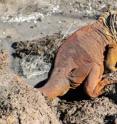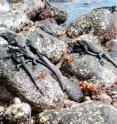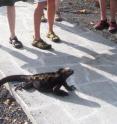Patterns of antibiotic-resistant bacteria found in Galapagos reptiles
Land and marine iguanas and giant tortoises living close to human settlements or tourist sites in the Galápagos Islands were more likely to harbor antibiotic-resistant bacteria than those living in more remote or protected sites on the islands, researchers report in a new study. Feces collected at several different sites from free-living reptiles harbored Escherichia coli bacteria that were resistant to ampicillin, doxycycline, tetracycline and trimethoprin/sulfamethoxazole. Another bacterial species collected from the feces, Salmonella enterica, was found to be only mildly resistant or not resistant at all to the same antibiotics, most likely because of the differing ecology of these two bacterial species in the gut, researchers said.
The study results are reported in the Journal of Wildlife Diseases.
This is not the first study to find that wild animals living near humans or affected by tourism can obtain antibiotic-resistant bacteria from that exposure, said University of Illinois animal sciences professor Roderick Mackie, who led the study. But it does offer researchers and wildlife managers a way to determine which vulnerable animal species are most at risk of exposure to human pathogens.
"Oceanic island systems such as the Galápagos archipelago are ideal for studying patterns and processes of ecology and evolution, such as antibiotic resistance," Mackie said. "Although the data are interesting, we don't have enough data to identify the likely source of antibiotic exposure and origin of the resistance genes, or to draw conclusions about transmission direction."
Also, it is not yet clear "to what extent this potential exposure translates to ongoing exchange of bacterial strains or bacterial traits," the researchers wrote. Further studies are needed "to understand better how human associations influence disease risk in endemic Galápagos wildlife."
The work was carried out by Emily Wheeler as part of her doctoral studies in Mackie's lab, and was supported by a U.S. Environmental Protection Agency STAR Fellowship and a student research grant from the Conservation Medicine Center of Chicago. Postdoctoral researcher Pei-Ying Hong and field biologist Lenin Cruz Bedon, of Isla Santa Cruz, Galápagos, are co-authors on the study.




